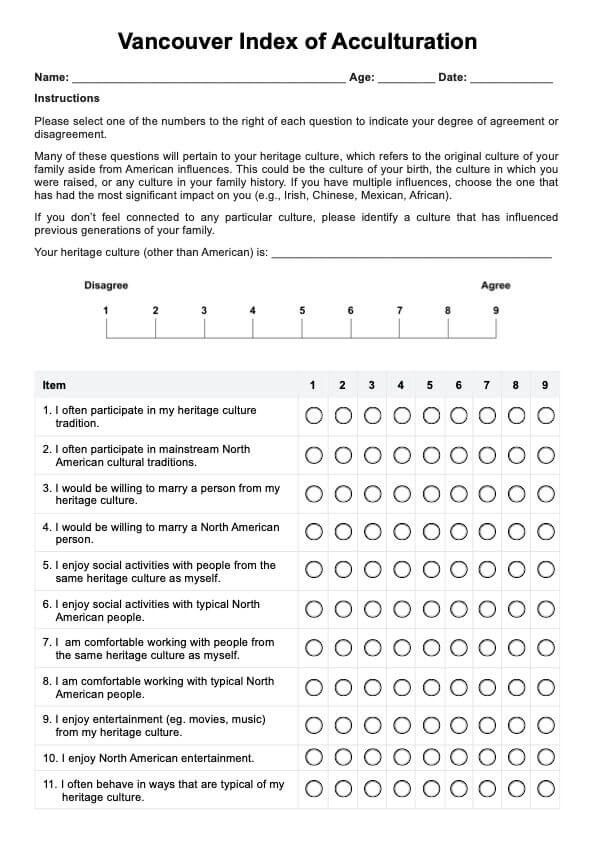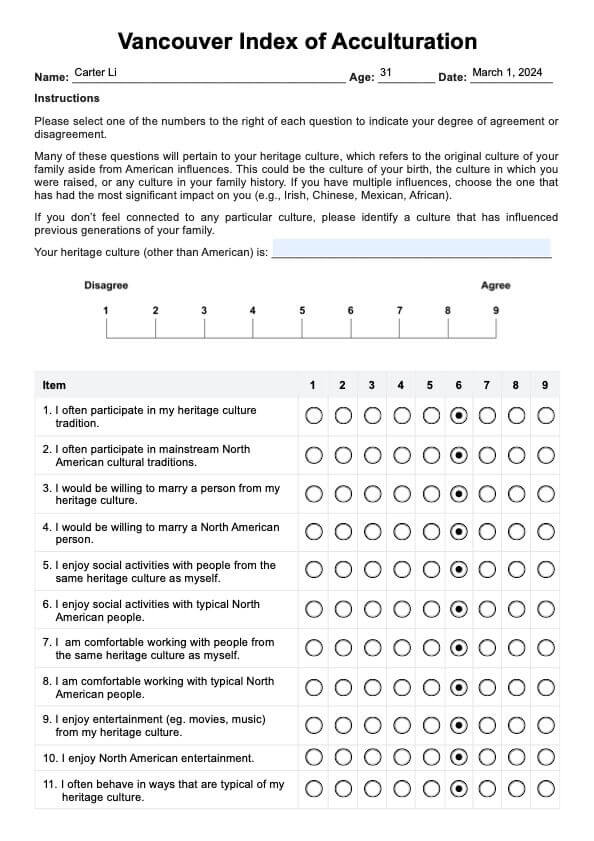Vancouver Index of Acculturation
Get access to a free Vancouver Index of Acculturation PDF. Learn how to use and score the index here.


What is the Vancouver Index of Acculturation?
Understanding the interplay between mainstream American values and heritage culture traditions is crucial for assessing the acculturation process of migrants. Mainstream American culture often emphasizes individualism (Rosenbaum, 2018; Zakaras, 2022), equality, and liberty, fostering a sense of belonging to a broader national identity. In contrast, heritage culture traditions focus on community, familial ties, and the preservation of historical practices, offering a sense of continuity and identity for migrants.
The Vancouver Index of Acculturation (VIA) is a self-report tool designed to evaluate acculturation, particularly among migrants. Developed by Ryder, Alden, and Paulhus in 2000, the VIA employs a bi-dimensional framework that distinguishes between adopting cultural practices from the host culture and preserving traditions related to one's heritage culture.
Comprising 20 items, the VIA evaluates two primary dimensions:
- Heritage acculturation: This dimension examines how deeply individuals engage with and uphold their original cultural practices and values.
- Mainstream acculturation: This dimension assesses the degree to which individuals integrate and adapt to the practices and values of the host culture.
Participants express their level of agreement with a series of statements regarding their cultural behaviors and preferences, enabling researchers to effectively measure their acculturation journey.
The psychometric properties of the VIA have been validated across various cultural contexts, demonstrating strong reliability, with Cronbach's alpha coefficients of 0.79 for Heritage and 0.75 for Mainstream (Ryder et al., 2000; Testa et al., 2019). Additionally, it exhibits measurement invariance across demographic groups, including gender and age.
Vancouver Index of Acculturation Template
Vancouver Index of Acculturation Example
How to use our Vancouver Index of Acculturation template
Carepatron has created a user-friendly Vancouver Index of Acculturation template for easy clinical documentation. Here's how to use it:
Step 1: Access the VIA
Open the Vancouver Index of Acculturation by clicking "Use template." You can also download it via the Carepatron app.
Step 2: Provide your patient a copy
You can share the VIA with your patient through email or print it out and give them a physical copy. Make sure to explain the purpose of the assessment and assure them that their responses will be kept confidential.
Step 3: Patient completes the index
Ask your patient to complete the VIA by indicating their level of agreement with each statement. Remind them that there are no right or wrong answers, and their responses will help in better understanding their acculturation journey.
Step 4: Score the results
Once your patient completes the index, score their results using the information provided in the template. Use their results to start a conversation about their level of acculturation and how it may impact their health and well-being.
Step 5: Incorporate into their care plan
Based on their results, incorporate any necessary interventions or adjustments into your patient's care plan. This can include cultural sensitivity training or accessing community resources that align with their cultural values and practices.
Step 6: Regularly re-evaluate
Make it a point to regularly re-evaluate your patient's level of acculturation using the VIA template. This will help track their progress and identify any changes in their cultural behaviors and preferences.
Vancouver Index of Acculturation scoring and interpretation
Scoring and interpreting the Vancouver Index of Acculturation is an easy process that offers valuable insights into an individual's journey through mainstream American cultural traditions and heritage. It helps to understand how an individual navigates between mainstream cultural orientations and several cultural contexts, reflecting their heritage culture and traditions.
Scoring
Each item on the VIA (Values in Action) is assessed using a Likert scale, which typically ranges from 1 (strongly disagree) to 9 (strongly agree). This scale allows respondents to express the intensity of their feelings regarding each statement, providing a nuanced understanding of their values.
Scores for each subscale are determined by summing the responses to the relevant items, which ensures a comprehensive evaluation of different aspects of character strengths. Specifically, the Heritage subscore is derived from the average of the odd-numbered items, reflecting values that are often rooted in cultural or personal history.
In contrast, the Mainstream subscore is calculated based on the average of the even-numbered items, emphasizing more contemporary or widely accepted values.
Interpretation
The interpretation of the scores on the VIA can provide valuable insight into an individual's acculturation process. Here are some general guidelines for interpreting the scores on each subscale:
- Heritage score: A high score suggests a strong identification with and maintenance of one's heritage culture. This could indicate that the individual has not fully adapted to mainstream American cultural traditions.
- Mainstream score: A high score indicates a strong identification with the host culture and adaptation to mainstream American cultural traditions.
- Balance between scores: If both scores are relatively equal, it may suggest that the individual has successfully integrated both their heritage culture and mainstream American cultural traditions.
There is no "right" or "wrong" score on the VIA, as everyone's acculturation process is unique. However, it can provide a starting point for discussions about cultural identity and adaptation.
Next steps after the assessment
After assessing your patient's acculturation level using the VIA, it is important to interpret the results in the context of their overall well-being. Acculturation can have a significant impact on an individual's mental and physical health, as well as their social relationships.
For individuals with high scores on both Heritage and Mainstream subscales, it may be beneficial to explore how they navigate between these two cultural identities and whether they experience any conflicts or stressors related to maintaining this balance. On the other hand, for those with low scores on both subscales, it may be helpful to investigate potential feelings of disconnection or isolation from both cultures.
In either case, providing support and resources tailored to an individual's specific acculturation experiences can greatly benefit their overall well-being. This may include connecting them with culturally sensitive mental health services, providing opportunities for community engagement and building relationships within their cultural communities, or offering resources to help navigate cultural differences in various aspects of life such as work, education, and healthcare.
References
Rosenbaum, A. (2018, October 31). Personal space and American individualism. Brown Political Review. https://brownpoliticalreview.org/2018/10/personal-space-american-individualism/
Ryder, A.G., Alden, L., & Paulhus, D.L. (2000). Is acculturation unidimensional or bidimensional?: A head-to-head comparison in the prediction of demographics, personality, self-identity, and adjustment. Journal of Personality and Social Psychology, 79, 49-65.
Testa, S., Doucerain, M. M., Miglietta, A., Jurcik, T., Ryder, A. G., & Gattino, S. (2019). The Vancouver Index of Acculturation (VIA): New evidence on dimensionality and measurement invariance across two cultural settings. International Journal of Intercultural Relations, 71, 60–71. https://doi.org/10.1016/j.ijintrel.2019.04.001
Zakaras, A. (2022, November 4). Alex Zakaras on the roots of American individualism. Princeton University. https://press.princeton.edu/ideas/alex-zakaras-on-the-roots-of-american-individualism
Commonly asked questions
To effectively assess the cultural orientations of recent migrants, the Vancouver Index of Acculturation (VIA) serves as a valuable tool. This instrument allows researchers to evaluate the balance between heritage culture and mainstream culture orientations. By exploring both cultural dimensions, the VIA provides insights into how migrants engage with their heritage traditions alongside their adaptation to typical American cultural practices.
The Vancouver Acculturation Index (VIA) is a self-report measure that assesses an individual's cultural orientation by examining their level of identification with both their heritage culture and the mainstream culture. It includes items that measure attitudes towards cultural traditions, values, and behaviors related to one's heritage and the mainstream culture. This allows researchers to gain a comprehensive understanding of an individual's acculturation experiences.
Mainstream traditions refer to the customs, practices, and genres of entertainment that are widely accepted and practiced within the dominant culture of a society, such as typically American cultural activities like Hollywood films, pop music, and contemporary sports. In contrast, heritage traditions encompass the unique customs and forms of entertainment rooted in a person's ancestry and cultural background. These might include traditional music, dance, and storytelling that reflect their same heritage culture.
Perceived discrimination can greatly impact how individuals enjoy entertainment, fostering feelings of alienation or discomfort in cultural spaces. When members of minority groups sense that their heritage and traditions are undervalued or stereotyped in mainstream entertainment, their participation in these activities may decline.




















-template.jpg)



















































































